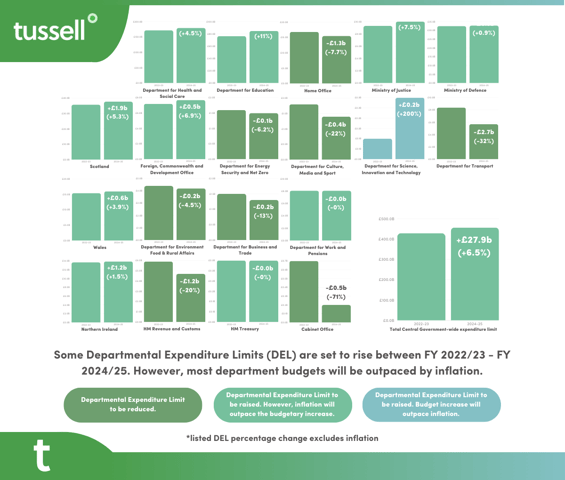On the 6th of March 2024, the Chancellor of the Exchequer presented his Spring Budget to Parliament.
Many of the Budget's announcements will impact public procurement - including the £4 billion investment into public sector "productivity", and a total per capita spending cut of 8% as compared to the plans set out in the Spending Review 2021.
In this blog, we break down exactly how the 2024 Spring Budget impacts public procurement, and what this all means for suppliers operating in the public sector marketplace.
Skip ahead to read about:
- Central Government
- Local Government
- The NHS
- Key investment areas
- Summary and conclusion: the Spring Budget
📉 Takeaway #1: spending power is falling
Firstly, the plans outlined in the Spring Budget make it clear that - with the exception of the NHS - public sector spending power is set to fall over the coming years.
Why? The answer is two-fold: high inflation in the past year, and a levelling-off or reduction in departmental and Local Government investment (echoing plans laid out in the 2023 Autumn Statement)
Below we've broken down what this looks like across the three main government verticals:
🏛️ Central Government
Most ministerial departments are set to face significant real-term cuts to spending power over the next few years.
In October 2023, the Institute for Fiscal Studies warned that departments were facing spending cuts of 3.4% per year. The Resolution Foundation similarly warns that the spending power of unprotected departments is set to fall by a staggering 16% in real terms over the next 5 financial years.
This is largely a result of high inflation levels in recent years. Hargreaves Lansdown and the ONS put RPI inflation at 13% for the period between April 2022 and January 2024.
This, in principle, means that any department set to see its Department Expenditure Limit (DEL) increase by less than +13% between FY 2022/23 and FY 2024/25 will not have kept pace with recent inflation levels - in other words, their spending power will be diminished.
Unfortunately, the Spring Budget shows that only one department - the Department for Science, Innovation and Technology - will see its budget outpace the 13% inflation figure. Other departments will either see their DEL increase below the 13% benchmark, or be cut.
Below, we've broken down the Spring Budget's DEL plans department-by-department. Click here to download the summary.
🏢 Local Government
The Local Government Association (LGA) claims that Local Government spending power has been cut by 23.3% in real terms between FY 2010/11 - FY 2024/25.
Whilst £500m has been pledged to Local Government in the Spring Budget to help with the rising cost of social care, the LGA says that too little has been done to support councils across the country.
Social care is one of Local Government's fastest-growing expenses, due to demographic shifts, population growth, minimum wage increases & inflation.
As such, many councils will enter the FY 2024/25 financial year in a precarious position, looking to cut costs where possible.
To learn more about the Local Government bankruptcy epidemic, read our explainer blog.
🏥 The NHS
In contrast to Central and Local Government, the Spring Budget promised a hefty, inflation-beating investment for the NHS.
The Spring Budget pledged an additional £2.5b for day-to-day running of the NHS in England across FY 2024/25. This brings the total NHS budget to £164.9b for the year and protects real term levels of funding.
An additional £3.4b in capital funding is also being made available to modernise NHS IT systems and increase productivity through digitisation.
Through this initiative, the government hopes to unlock £35b in cumulative productivity savings.
*
So, what does this mean?
Under current plans, Central and Local Government authorities are set to see their spending power fall sharply over the coming years.
This will undoubtedly have a knock-on effect for the public procurement marketplace - be it a tightening in procurement spend, fewer tender opportunities, or a greater reliance on frameworks to cut costs.
Now more than ever, it's imperative to follow the money and see which buyers are continuing to spend the most in your niche under these circumstances.
📈 Takeaway #2: investing in productivity
The government hopes that some of these spending constraints will be alleviated by its plans to boost public sector productivity.
Productivity and AI were major themes in the Spring Budget, mentioned 77 times and 25 times respectively.
According to the Chancellor, Jeremy Hunt, public sector productivity is 5.9% below pre-pandemic levels. The Spring Budget has set aside significant budget in both the NHS and some Central Government departments to claw that productivity back.
Most of this productivity budget has been ring-fenced for transformation, digitisation and automation of back-end services.
Some funds have also been set aside for AI research and development, and small pockets have also opened up across social care and infrastructure.
🚑 NHS Productivity and Transformation
£3.4b has been pledged to reform IT systems in UK healthcare.
This investment will double the NHS’ digital transformation budget, and includes ring-fenced funds in the following areas:
-
£430m to transform access and services. This will include large investments in virtual appointments, development of the NHS app, and digitally-enabled early intervention services.
-
£1b for automation and data transformation. This includes automating back-office functions and developing of the NHS staff app. Specifically, the Government hopes to automate discharge summaries and GP notes. They also hope to accelerate the FDP (Federated Data Platform) which will allow for better data sharing across ICSs.
-
£2b to be invested in updating outdated IT systems. Budget has been set aside to upgrade MRI scanners with AI and to digitise the transfer of care process. The Government also hopes to scale up AI usage across the whole NHS.
Key goals of the funding include reducing waiting times, increasing productivity and improving patient outcomes.
Uncover the fastest-growing healthtech suppliers in the 2023 Tech200
Productivity improvements are to be measured at an ICB and trust level and new incentives will be introduced to reward NHS providers that deliver productivity increases.
What does this mean for suppliers in this space?
Tussell analysis shows that direct spending between NHS bodies and IT suppliers has increased year-on-year. The Spring Budget's investment into NHS digitisation will only accelerate this spending further.
IT and digital suppliers looking to sell to the NHS are well-positioned to do so if they can demonstrate that their solution offers a significant productivity gain.
-3.png?width=571&height=485&name=Graphs%20for%20blogs%20(1)-3.png)
⚖️ Modernising Justice
In addition to the large carve-outs for NHS tech, the Spring Budget promised a wave of investment into modernising and digitising justice.
£230m has been set aside to deliver police technology pilot schemes. These schemes will include the use of facial recognition software and the automation of 101 calls.
Additionally, Family Courts will receive £55m to offer online legal guidance as part of a £170m pledge to deliver a "justice system fit for the modern era".
Part of this £170m will also be used to support prison rehabilitation and reduce reoffending rates. Finally, £15m will be used to help digitise the court system.
AI will also be piloted in various projects across the justice sector.
With this investment comes new opportunities for you to expand into the justice sector - turn to the data to understand which justice authorities have historically spent the most on digitisation schemes - or have yet to - and keep track of the new tender opportunities this investment could spur.
🤖 AI & technology
£34m has been set aside for the Public Sector Fraud Authority to use AI to combat fraud.
The size of the AI in-house incubator team is also set to double, and £17m has been pledged to the DWP to digitally transform the department.
.png?width=591&height=502&name=AI%20contracts%20-%20Spring%20Budget%20Blog%20(1).png)
Tussell data shows that Q1 of 2024 is set to see the highest-ever value of AI-related contracts be awarded by public sector bodies. It's safe to say that the public sector are fully invested in the growing capabilities of AI, and are now turning to the market to adopt it into how they operate.
🤗 Community, education & social care
In addition to the £500m for Local Government social care, money has also been set aside for a small array of social projects:
-
£105m for the creation of 15 new special needs schools.
-
£75m (over three years) to expand the Violence Reduction Unit model across England and Wales.
-
£45m to build an additional 200 open children’s home placements, and £120m to maintain existing children's homes, and rebuild Atkinson Secure Children’s Home and Swanwick Secure Children’s Home.
-
£35m to improve maternity safety via the recruitment of new midwives and the rolling out of the 'Avoiding Brain Injuries in Childbirth [training] Programme'.
🚂 Transportation & infrastructure
The budget reiterated the government's commitment to spend over £600b for investment in UK infrastructure over the next 5 years.
This includes plans to work with OFGEM to upgrade the national grid & to reinvest the money saved in the cancellation of HS2 into alternative projects through Network North.
🌷 Summary & Conclusion
Departmental budget cuts, and mounting pressures on the NHS and Local Government to deliver value for money, may be cause for concern to some public sector suppliers.
If these budgetary plans remain in place, many public bodies will simply have less money to spend on procurement activities. This will inevitably affect contracting authorities' procurement priorities, how much they're willing to spend, and where 'value' is placed when awarding contracts.
Suppliers must be conscious of these budgetary pressures and constraints when engaging with buyers - both when deciding how to pitch your product or service, and how to competitively price your offering.
Nevertheless, the era of big government is certainly far from over, and the 2024 Spring Budget offers plenty of opportunities for the right suppliers.
.png?width=1920&height=1080&name=Tussell%20-%20Procurement%20Notices%20Publication%20Matrix%20-%202024_02_28%20(1).png)
As the Government incentivises NHS bodies to boost productivity, the burden will partly fall upon technology companies (and other suppliers) to demonstrate how their solutions provide both value for money and offer a significant productivity boost.
Moreover, ring-fenced funding for modernising the justice system, implementing AI solutions, and improving infrastructure will undoubtedly bring opportunities for suppliers in these spaces.
A new government following the next general election may upend, reverse of expand upon the measures introduced in this year's Spring Budget.
But whichever party is in power, the public sector will continue to rely on and turn to private sector suppliers to help it address perennial issues: from the demographic pressures being placed onto social care, to the need to drive efficiency and save taxpayers money.
If you want to keep track of where government is spending, and all of the latest contract opportunities public bodies are releasing, you'll first need a tool like Tussell.
Tussell is the market's trusted source of public sector market insights, helping suppliers better understand their target market, keep on top of opportunities, and do more business with government.
Book a demo with the Tussell team to find out how you can benefit from Tussell's insights.




%20v1.png)













